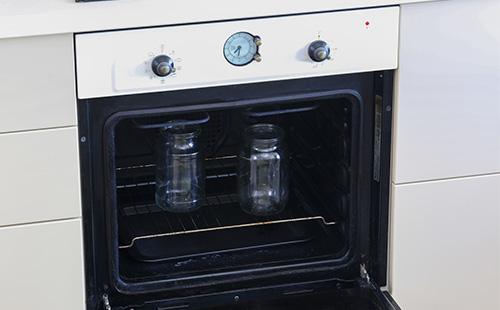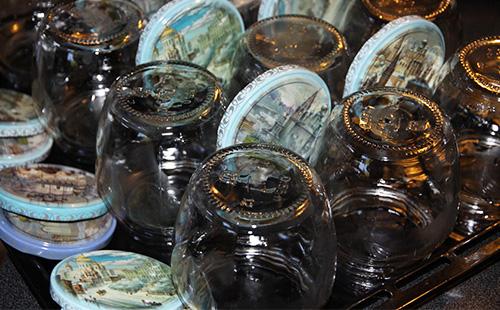Already in the X century, home preservation was widespread in Russia: salty and pickled products adorned the tables of both the commoner and the master. At that time, blanks were stored in wooden tubs and barrels, and only in Soviet times, during the period of mass urbanization, the widespread use of glass jars began.
Method Advantages
The advantage of the method is the simultaneous processing of a large number of containers. While the process is underway, you can do your own thing, and not stand at the stove. Here are the "bonuses" of this method of sterilization:
- efficiency- under the influence of a high heating temperature, bacteria die;
- comfort- steam does not accumulate in the kitchen, as when processing cans in a water bath, the room does not become stuffy;
- dryness- since sterilization is carried out without water, you do not need to wait until the containers are dry;
- security- subject to basic precautions, the risk of burns is minimal;
- preservation of cans- tanks, subject to certain rules, rarely crack.
rules
Sterilize the jars immediately before laying the blanks, it is impractical to do this in advance. In extreme cases, the containers can be placed on a clean towel for several minutes, turned upside down. Here are six more rules that can help sterilize jars in the oven.
- Purity. The oven must be clean, otherwise the jars will absorb unnecessary odors, which will negatively affect the taste of the workpiece.
- "Free" arrangement. The cans placed in the oven should not be in contact, otherwise, if some kind of container is cracked, standing next to it will also be unsuitable.
- Gradual heating. The main reason that during the preservation process glass containers crack, in a sharp temperature difference. To avoid this, the cans are always placed in a cold oven, which is heated gradually. Before you get the containers, for the same reason, you need to let them cool slightly.
- Duration If the jars are not in the oven for long enough, not all bacteria will die, if the containers are overexposed, they may burst.
- Use of gloves. Remove cans from the oven only in oven mitts to prevent burns. At the same time, they must be absolutely dry so that the container does not burst from a temperature difference.
- The correct grip. Hold the jar with only two hands, clasping on both sides. It is impossible to lift the container by the neck: it can slip and fall.

How to sterilize cans in the oven: practice
The process begins with a thorough inspection of the containers: cans with cracks, chips and stubborn dirt that are permanently stuck in it are immediately discarded.
Electric
The most optimal is the sterilization of cans in an electric oven, since the gas temperature can be uneven. A step-by-step process can be represented as a four-stage algorithm.
- Cleansing. Rinse all cans with running water and soda or laundry soap.
- Accommodation Place empty containers on a baking sheet or wire rack and place in a cold oven. Put dry cans upside down, wet ones - with the neck up.
- The heating. Slowly heat the oven. A temperature of 150 ° C is considered optimal for sterilizing cans in an electric oven. Track time (depending on volume, see below).
- Extraction. Carefully remove the containers and turn them upside down on clean towels.
The processing time depends on the capacity of the containers. The table below contains information on how many minutes to sterilize the cans in the oven.
Table - Duration of sterilization
| Capacity (in liters) | Time (in minutes) |
|---|---|
| 0,5 | 10 |
| 1 | 15 |
| 2 | 20 |
| 3 | 25-30 |
Gas
You can sterilize cans in a gas oven. To do this correctly, you must follow the algorithm described above, with two caveats.
- Fire intensity. Heat the oven over low heat.
- Temperature. The cans are sterilized at a temperature of 180 ° C.
The processing time is the same as when using an electric oven.

With blanks
In some preservation methods, not only empty but also filled with blanks cans are sterilized before rolling. This is necessary to extend the shelf life of home pickles. Sterilization of cans with blanks can be carried out in the oven. Processing is carried out in three steps.
- Installation Place full cans, covered but not covered by lids, on a baking sheet and send to a cold oven.
- The heating. Gradually bring the temperature to 100 ° C and note the time. Half liter containers are sterilized for ten minutes. Banks, with a volume of 1 liter, - 15 minutes, 2 and 3 liters - 20-25 minutes.
- Extraction. Get cans using tacks, roll up, turn upside down, place on a tray and wrap the blanket until it cools completely.
In the oven, you can pasteurize cans with blanks. This process differs from sterilization by a lower heating temperature - 80-90 ° C. The method is mainly used in the manufacture of compotes and marinades.
Sterilizing cans in the oven is a time-consuming process that saves time. If three-liter cans do not enter the electric oven vertically, you can put them on their side. And if the old gas oven does not provide uniform heating, you can put one or two bricks in it.
Other homemade recipes
Sea buckthorn with sugar without cooking
Salad Tourist Breakfast with Rice
Sea buckthorn jelly
Caviar from green tomatoes for the winter

